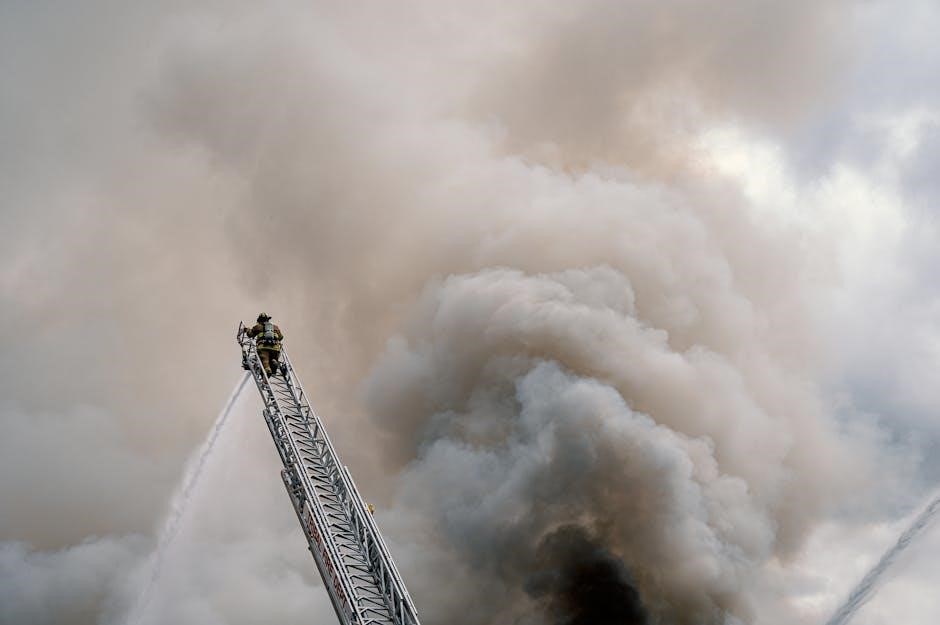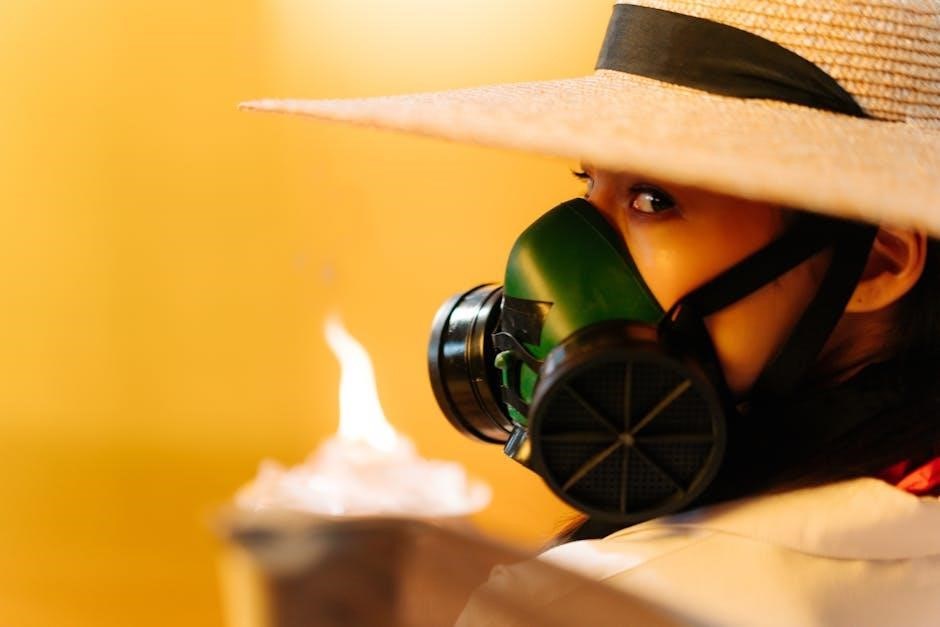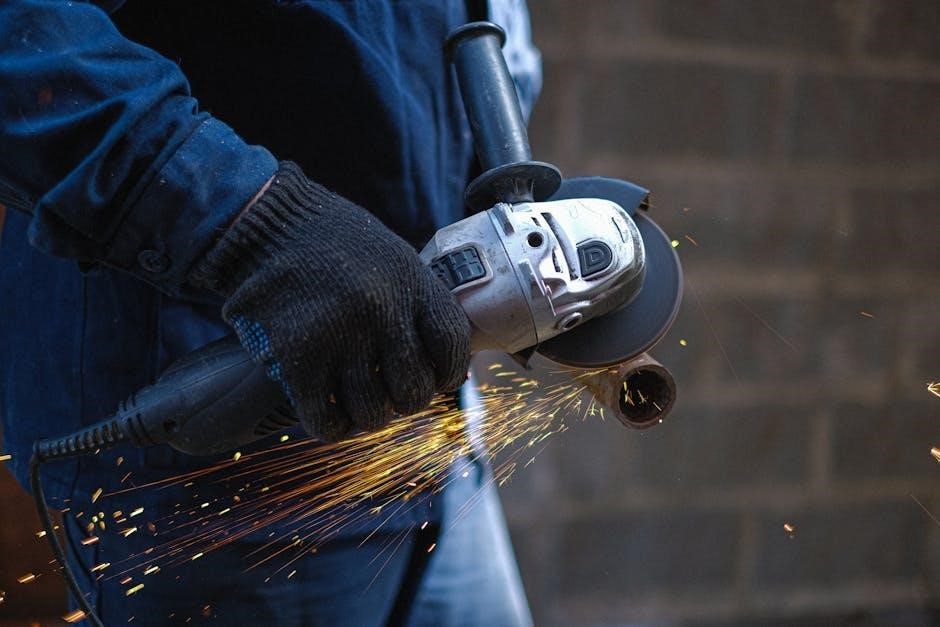NFPA 285 provides a standardized method for assessing fire propagation in exterior walls with combustible components, ensuring fire safety in construction. It guides architects, contractors, and safety professionals.
1.1 Overview of the Standard
NFPA 285 is a fire test method standard evaluating exterior wall assemblies containing combustible components. It assesses fire propagation characteristics, ensuring materials meet safety requirements. The standard provides a framework for testing assemblies under controlled conditions to determine their resistance to fire spread. This is crucial for maintaining fire safety in buildings, especially in high-rise structures. Compliance with NFPA 285 helps prevent fire hazards and ensures occupant safety.
1.2 Importance of Fire Safety in Construction
Fire safety is critical in construction to protect lives, property, and the environment. Uncontrolled fires can lead to catastrophic losses, making it essential to implement robust safety measures. NFPA 285 plays a key role by providing standardized testing methods to evaluate fire propagation in exterior wall assemblies. This ensures materials and designs meet safety criteria, reducing fire hazards and promoting occupant safety in buildings. Adhering to such standards is vital for preventing fire-related disasters.
Scope and Purpose of NFPA 285
NFPA 285 is a fire test method for exterior wall assemblies with combustible components, ensuring fire safety by evaluating and mitigating fire propagation risks in construction.
2.1 Definition of Exterior Wall Assemblies
Exterior wall assemblies refer to the components of a building’s outer walls, including cladding, insulation, and structural elements. NFPA 285 focuses on assemblies containing combustible materials, ensuring they meet fire safety standards. These assemblies are critical in preventing fire spread and maintaining structural integrity during a fire. The standard applies to both new and existing constructions, providing a framework for evaluating their fire resistance and propagation characteristics.
2.2 Objectives of the Standard
The primary objective of NFPA 285 is to ensure fire safety by evaluating the fire propagation characteristics of exterior wall assemblies containing combustible components. It provides a standardized test method to assess how fire spreads within these assemblies, helping to prevent rapid fire progression. The standard aims to ensure materials and systems meet fire performance criteria, protecting both occupants and structures. By establishing clear testing protocols, NFPA 285 promotes compliance with fire safety codes and enhances building design safety.
Test Methodology
NFPA 285 outlines a standardized approach to evaluate fire propagation in exterior wall assemblies under controlled conditions, including ignition sources and monitoring of thermal exposure.
3.1 Fire Propagation Characteristics
NFPA 285 evaluates how fire spreads across exterior wall assemblies, focusing on combustible components. It assesses flame spread, heat release, and potential fire penetration. The standard ensures walls resist fire propagation, maintaining structural integrity and reducing risks of spreading to adjacent areas or interiors. Testing involves exposing assemblies to controlled ignition sources, measuring fire behavior, and ensuring compliance with safety criteria to prevent uncontrolled fire spread.
3.2 Test Setup and Procedures
NFPA 285 outlines detailed test setup and procedures to evaluate fire propagation. The test involves assembling exterior wall components in a controlled environment, exposing them to a standardized ignition source. The setup includes instrumentation to measure flame spread, heat flux, and gas temperatures. Procedures ensure consistent testing conditions, enabling accurate assessment of fire behavior and resistance. Adherence to these steps ensures reliable results, critical for compliance and fire safety evaluations.

Test Apparatus and Materials
NFPA 285 requires specific apparatus, including heat flux gauges, thermocouples, and cameras, to measure fire behavior. Materials tested include exterior wall components with combustible elements, ensuring fire resistance and propagation assessment accuracy.
4.1 Required Equipment for Testing
NFPA 285 specifies essential equipment for fire propagation testing, including heat flux gauges, thermocouples, and high-speed cameras. These tools measure temperature, heat transfer, and flame spread dynamics. Additionally, a controlled ignition source and ventilation system are required to simulate real-world fire scenarios. The equipment ensures accurate data collection, enabling precise evaluation of exterior wall assembly performance under fire conditions. Proper calibration and setup of this equipment are critical for reliable test results.
4.2 Materials Used in Exterior Wall Assemblies
NFPA 285 evaluates materials in exterior walls, including insulation, cladding, and combustible components. These materials are tested for fire performance, focusing on flame spread and heat release. The standard ensures materials meet specific criteria to prevent fire propagation. Proper material selection is crucial for fire safety, helping architects and builders design exterior walls that minimize fire risks and protect occupants.

Test Specimen Preparation
NFPA 285 requires test specimens to be prepared according to specific dimensions and construction guidelines to ensure accurate fire testing. Proper installation is critical.
5.1 Dimensions and Construction
NFPA 285 specifies precise dimensions and construction requirements for test specimens to ensure accurate fire testing. Specimens must replicate real-world exterior wall assemblies, including combustible components. The standard outlines exact measurements for height, width, and material placement to maintain consistency. Proper construction ensures that fire propagation characteristics can be reliably assessed, aligning with the standard’s objectives for fire safety evaluation in building design and compliance with fire codes.
5.2 Installation of Specimens
NFPA 285 requires precise installation of test specimens to ensure accurate fire testing. Specimens must be securely anchored to the test apparatus, with all gaps sealed to prevent fire spread outside the assembly. The installation process replicates real-world conditions, including proper ventilation and material interfaces. Correct installation is critical to obtaining reliable data on fire propagation characteristics, ensuring compliance with fire safety standards and accurate evaluation of exterior wall assemblies.

Conducting the Test
NFPA 285 outlines standardized procedures for conducting fire tests on exterior wall assemblies, ensuring precise execution to evaluate fire propagation and flame spread characteristics accurately.
6.1 Ignition and Flame Spread
NFPA 285 evaluates how exterior wall assemblies ignite and spread flames under controlled conditions. The test uses a gas burner to apply heat and flames to the specimen. Observations focus on the time to ignition, lateral flame spread, and vertical flame propagation. The standard ensures that materials and assemblies meet specific fire performance criteria, critical for preventing rapid fire spread in buildings. This step is vital for assessing real-world fire risks and ensuring occupant safety.
6.2 Monitoring and Data Collection
During NFPA 285 testing, data collection involves monitoring temperature, flame spread, and material degradation. Thermocouples and cameras record real-time conditions. The test measures the time to ignition, flame height, and heat release. Data loggers capture thermal performance metrics, ensuring accurate results. This information is critical for assessing fire propagation risks and determining compliance with safety standards. Proper documentation ensures reliable results, aiding in material evaluation and fire safety compliance for exterior wall assemblies.

Evaluating Test Results
Test results are evaluated based on flame spread, heat release, and material performance. Compliance is determined by predefined criteria, ensuring fire safety and structural integrity in exterior walls.
7.1 Criteria for Passing the Test
The criteria for passing NFPA 285 include limiting flame spread, controlling heat release rates, and preventing fire penetration. The assembly must maintain structural integrity, with no ignition of adjacent materials. These standards ensure the exterior wall assembly minimizes fire propagation risks, aligning with safety goals and building codes. Compliance is verified through rigorous testing and data analysis, ensuring materials meet fire performance requirements for safe construction practices.
7.2 Interpretation of Data
Interpreting NFPA 285 test data involves analyzing flame spread, heat release rates, and fire penetration. Key metrics are compared against pass/fail criteria to assess fire performance. Data interpretation ensures materials meet safety standards, guiding design modifications and material selection. Accurate analysis is crucial for compliance, ensuring exterior wall assemblies minimize fire risks in construction projects.

Implications for Building Design
NFPA 285 influences building design by ensuring exterior wall assemblies meet fire safety standards, guiding material selection, and promoting compliance with fire codes to enhance occupant safety.
8.1 Compliance with Fire Codes
NFPA 285 ensures exterior wall assemblies comply with fire safety regulations, reducing fire hazards in buildings. It provides a standardized method to evaluate materials and designs, helping architects and contractors meet local fire codes. Compliance with NFPA 285 is often mandated by authorities, ensuring structures are designed to protect occupants and property from fire risks. Adherence to this standard is crucial for maintaining safety and meeting regulatory requirements in construction projects.
8.2 Material Selection and Design Considerations
Material selection and design considerations are critical in ensuring exterior wall assemblies meet NFPA 285 requirements. Combustible components must be evaluated for their fire propagation characteristics. Design elements, such as joints and fenestrations, should minimize fire spread. Architects and engineers must consider thermal performance, structural integrity, and flame spread resistance. Proper material selection and design practices help prevent fire hazards, ensuring safer buildings while maintaining aesthetic and functional goals. Adherence to these guidelines is essential for effective fire safety.
Fire Safety in High-Rise Buildings
NFPA 285 ensures fire safety in high-rise buildings by testing exterior wall assemblies to prevent fire spread, protecting occupants and maintaining structural integrity during emergencies.
9.1 Role of Exterior Walls in Fire Containment
Exterior walls play a critical role in fire containment by acting as a barrier to prevent fire spread between buildings and within high-rise structures. NFPA 285 evaluates how exterior wall assemblies resist fire propagation, ensuring they maintain structural integrity and limit flame spread. This is vital for occupant safety, as it delays fire penetration and reduces the risk of rapid fire spread, especially in densely populated urban areas with tall buildings.
9.2 Specific Requirements for High-Rise Structures
NFPA 285 imposes strict fire performance criteria for high-rise buildings to mitigate fire risks. Exterior wall assemblies must resist fire spread and maintain structural integrity under extreme conditions. The standard requires enhanced fire resistance, limits on flame spread, and thermal barrier protection. These measures ensure occupant safety and prevent fire propagation in tall buildings, where evacuation is challenging and fire spread can have catastrophic consequences.
Role of NFPA 285 in Fire Safety Regulations
NFPA 285 plays a critical role in fire safety by providing standardized testing for exterior walls, ensuring compliance with fire codes and protecting against combustion risks.
10.1 Adoption by Authorities
NFPA 285 is widely recognized and adopted by local, state, and international building codes as a critical standard for fire safety. Authorities enforce its guidelines to ensure exterior wall assemblies meet fire performance requirements, reducing risks of fire spread. The standard’s adoption underscores its role in maintaining public safety and compliance with fire codes, making it a cornerstone for regulatory bodies worldwide.
10.2 Impact on Building Codes
NFPA 285 significantly influences building codes by establishing fire performance benchmarks for exterior wall assemblies. Its adoption leads to stricter regulations, ensuring materials and designs meet fire safety standards. This standard drives updates in local and international codes, promoting safer construction practices. By integrating NFPA 285, building codes enhance fire protection, reducing risks and ensuring compliance with modern safety requirements.

Comparison with Other Fire Testing Standards
NFPA 285 differs from standards like ASTM E119 by focusing on fire propagation in exterior walls with combustible components, offering unique testing methodologies for modern construction materials.
11.1 ASTM E119 and NFPA 285
ASTM E119 and NFPA 285 are both fire testing standards but differ in scope. ASTM E119 focuses on fire resistance of building materials, while NFPA 285 specifically evaluates fire propagation in exterior wall assemblies containing combustible components. NFPA 285 addresses modern construction materials and assemblies, complementing ASTM E119 by providing additional safety measures for exterior walls. Both standards are critical for ensuring fire safety but serve distinct purposes in construction and material testing.
11.2 Differences in Test Methods
NFPA 285 and ASTM E119 differ in their test methods and objectives. NFPA 285 uses a specific burner and setup to evaluate fire propagation on exterior walls, while ASTM E119 focuses on fire resistance using a furnace test. NFPA 285 emphasizes real-world fire scenarios, whereas ASTM E119 measures structural integrity under controlled conditions. These differences reflect their distinct goals: NFPA 285 addresses exterior wall fire spread, while ASTM E119 assesses material fire resistance.

Challenges and Limitations
NFPA 285 faces challenges like complex test setups, high costs, and limited scalability for large structures. These factors can hinder widespread adoption and practical application.
12.1 Technical Challenges in Testing
NFPA 285 testing involves complex setups, requiring precise control of heat flux and pressure. The large scale of specimens can complicate data collection and interpretation. Ensuring realistic fire scenarios while maintaining test repeatability is challenging. Additionally, the cost and availability of specialized equipment can hinder testing. These technical challenges highlight the need for skilled personnel and advanced facilities to conduct accurate assessments of exterior wall assemblies under fire conditions effectively.
12.2 Limitations of the Standard
NFPA 285 primarily focuses on fire propagation in exterior walls with combustible components but may not address all materials or designs. The standard’s test conditions are highly controlled, which might not fully replicate real-world fire scenarios. Additionally, the cost and availability of specialized testing facilities can limit its application. These limitations highlight the need for complementary testing methods and ongoing research to enhance the standard’s applicability and effectiveness in diverse construction contexts.

Case Studies and Real-World Applications
Case studies demonstrate NFPA 285’s practical application in construction projects, highlighting successful implementations and lessons learned from test failures, aiding in improving fire safety standards.
13.1 Successful Implementation in Construction Projects
NFPA 285 has been successfully applied in various construction projects, ensuring compliance with fire safety standards. Its implementation has facilitated the use of combustible materials in exterior walls while maintaining fire safety. Real-world applications demonstrate how the standard aids in material selection and design, enabling architects to meet both aesthetic and safety goals. Successful projects highlight the effectiveness of NFPA 285 in balancing construction objectives with fire safety requirements.

13.2 Lessons Learned from Test Failures
Test failures under NFPA 285 have provided valuable insights into material limitations and design flaws. These instances highlight the importance of proper material selection, installation, and adherence to test protocols. Failures often stem from incompatible components or procedural errors, emphasizing the need for rigorous quality control. Lessons learned have led to improved specifications and better understanding of fire propagation risks, ultimately enhancing the reliability of exterior wall assemblies in construction projects.
Future of Fire Testing and NFPA 285
The future of fire testing and NFPA 285 lies in advancing technologies and materials, potentially leading to updated standards that enhance fire safety and compliance in construction.
14.1 Advances in Testing Technology
Advances in testing technology are revolutionizing how fire propagation is assessed in exterior wall assemblies. Modern equipment enables precise measurement of heat flux, flame spread, and gas emissions. Automation and real-time data collection improve test accuracy and efficiency. These innovations allow for better understanding of material behavior under fire conditions, ensuring safer designs. They also facilitate compliance with evolving fire safety standards, benefiting the construction industry and public safety.
14.2 Potential Revisions to the Standard
NFPA 285 may undergo revisions to address emerging materials and technologies. Updates could include new test methods for advanced composites or improved criteria for assessing fire performance. Stakeholder feedback and lessons from real-world applications may also drive changes. Revisions aim to enhance clarity, safety, and applicability while keeping pace with evolving construction practices. These updates ensure the standard remains effective in mitigating fire risks in modern buildings.
Conclusion
NFPA 285 is a critical standard for ensuring fire safety in construction, providing essential guidelines for evaluating exterior wall assemblies. Its principles are indispensable for modern building design.
15.1 Summary of Key Points
NFPA 285 is a critical standard for evaluating fire propagation in exterior wall assemblies with combustible components. It provides detailed test methods and criteria for assessing fire safety. The standard ensures that materials and designs meet rigorous fire performance requirements, reducing risks in construction. By adhering to NFPA 285, architects and contractors can ensure compliance with fire codes and enhance building safety. Its guidelines are essential for modern construction practices.
15.2 Final Thoughts on the Importance of NFPA 285
NFPA 285 is a cornerstone for ensuring fire safety in construction, particularly for exterior wall assemblies with combustible components. Its standardized testing and criteria are vital for preventing fire disasters. By guiding material selection and design, the standard promotes compliance with fire codes and enhances building safety. NFPA 285’s rigorous approach ensures that modern construction practices prioritize fire prevention, safeguarding lives and property. Its adoption is essential for maintaining high safety standards in the industry.
